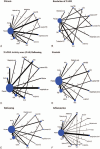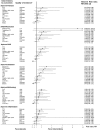Comparative efficacy of interventions on nonalcoholic fatty liver disease (NAFLD): A PRISMA-compliant systematic review and network meta-analysis
- PMID: 27512874
- PMCID: PMC4985329
- DOI: 10.1097/MD.0000000000004529
Comparative efficacy of interventions on nonalcoholic fatty liver disease (NAFLD): A PRISMA-compliant systematic review and network meta-analysis
Abstract
Background: The prevalence of nonalcoholic fatty liver disease (NAFLD) has significantly increased over the last decades. Despite existence of several interventions, there remains unclear which interventions work the best.
Methods: A systematic review and network meta-analysis of randomized trials comparing efficacy of all treatment options in NAFLD were performed to determine comparative efficacy and safety of interventions in the management of NAFLD. Several electronic databases were searched up to Nov 15, 2015. Outcomes include liver histological outcomes (i.e., fibrosis), all-cause mortality, cirrhosis, and safety. A network meta-analysis was applied to estimate pooled risk ratios (RR). Quality of evidence was assessed using GRADE criteria.
Results: A total of 44 studies (n = 3802) were eligible. When compared with placebo, obeticholic acid (OCA) was the only intervention that significantly improved fibrosis with RR (95% CI) of 1.91 (1.15, 3.16), while pentoxyfylline (PTX) demonstrated improved fibrosis without statistical significance with RR (95% CI) of 2.27 (0.81, 6.36). Only thiazolidinedione (TZD) and vitamin E use resulted in significant increase in resolution of NASH, while OCA, TZD, and vitamin E significantly improved other outcomes including NAS, steatosis, ballooning, and inflammation outcomes. Quality of evidence varied from very low (i.e., metformin, PTX on mean change of ballooning grade) to high (OCA, TZD, vitamin E on improving histological outcomes). Limitations of this study were lack of relevant long-term outcomes (e.g., cirrhosis, death, safety), possible small study effect, and few head-to-head studies.
Conclusions: Our study suggests potential efficacy of OCA, TZD, and vitamin E in improving histologic endpoints in NAFLD. These findings are however based on a small number of studies. Additional studies are awaited to strengthen this network meta-analysis.
Conflict of interest statement
The authors have no conflicts of interest to disclose.
Figures


References
-
- Chalasani N, Younossi Z, Lavine J, et al. AASLD practice guideline. The diagnosis and management of non-alcoholic fatty liver disease: practice Guideline by the American Association for the Study of Liver Diseases, American College of Gastroenterology, and the American Gastroenterological Association. Hepatology 2012; 5:2005–2023. - PubMed
-
- Watanabe S, Hashimoto E, Ikejima K, et al. Evidence-based clinical practice guidelines for nonalcoholic fatty liver disease/nonalcoholic steatohepatitis. Hepatol Res 2015; 45:363–377. - PubMed
-
- Ahmed A, Wong RJ, Harrison SA. Nonalcoholic fatty liver disease review: diagnosis, treatment, and outcomes. Clin Gastroenterol Hepatol 2015; 13:2062–2070. - PubMed
-
- Rinella ME. Nonalcoholic fatty liver disease: a systematic review. JAMA 2015; 313:2263–2273. - PubMed
Publication types
MeSH terms
Substances
LinkOut - more resources
Full Text Sources
Other Literature Sources
Medical

